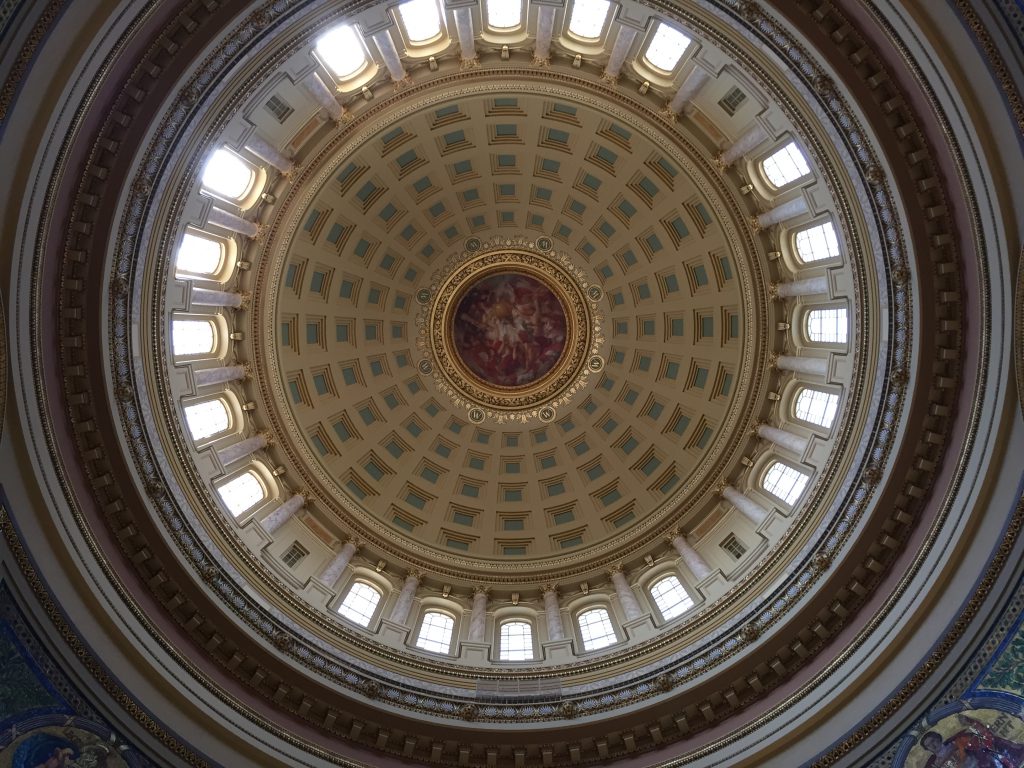State’s Historic $6.5 Billion Surplus Small Compared to Minnesota’s
Many states are flush with cash. Minnesota has $18 billion surplus.
Wisconsin’s projected budget surplus is massive. Game-changing. Historic.
And compared to other states around the country, it’s kind of ordinary.
“I’d actually say that policymakers in most states are navigating an unusual mix right now of temporarily strong financial conditions,” said Justin Theal, a state budget expert with The Pew Charitable Trusts.
One need not look far for examples. Neighboring Michigan, for example, is sitting on a similarly large $6 billion surplus based on its projections. In Minnesota, the numbers are more staggering, with a projected surplus of nearly $18 billion headed into the next budget cycle.
“It’s an extraordinary number,” said Larry Jacobs, a professor of political science at the University of Minnesota. “It’s got people flabbergasted by how much there is.”
In surplus states, common threads emerge
Every state’s budget is the product of countless decisions by legislators and governors dating back years, or even decades, but there are common threads among states expecting budget surpluses right now.
Topping that list is a national economy where people are earning more and spending more, leading to higher-than-expected revenue for states in the form of income, sales and corporate taxes.
“There was unprecedented amounts of federal aid that went directly to state governments,” Theal said.
Another factor contributing to surpluses, Theal said, is that many states took a cautious approach to spending during the pandemic.
“Conservative revenue forecasting played a big role here,” Theal said.
During the early days of the pandemic, fears of a recession led Gov. Tony Evers‘ administration to call for lapses, or temporary budget cuts, throughout state government. But as the state emerged from the recession, each revenue forecast has been bigger than the last.
Wisconsin’s Midwest neighbors see big surpluses, but different political circumstances
Evers’ administration announced recently that Wisconsin’s surplus will hit $6.6 billion by July, when the state begins its next two-year budget cycle. That’s on top of the $1.7 billion Wisconsin has in its budget stabilization fund, known as its rainy day fund.
While a surplus that large is without precedent in Wisconsin, it pales in comparison to the projected $17.6 billion budget surplus in Minnesota.
“It is shocking — $18 billion is shocking to legislators themselves,” Jacobs said. “This was not expected.”
But in November, Walz won reelection and Democrats won control of the Minnesota Legislature, giving them single-party control of state government for the first time in a decade. Jacobs said it’s created a “ferocious” competition among Democrats about how to handle the money.
“Because now you’ve put all these groups that have had expectations thwarted for about a decade who are coming forward with their dream budgets,” Jacobs said. “It’s left a number of Republicans quite fearful.”
A similar pattern played out in Michigan, where for the past four years, Democratic Gov. Gretchen Whitmer and Republican legislators ran state government.
“So there has been sort of party friction between the executive and legislative branch,” said Eric Lupher, the president of the Citizens Research Council of Michigan.
Lupher said the two sides never found broad agreement over how to use the state’s budget surplus, which has now grown to $6 billion. And in November, Democrats won control of the state Legislature.
“So all of a sudden, the Democratic party leadership finds themselves able to prioritize and really make some investments where we’ve been very budget constrained for a few decades now,” Lupher said.
Even as budget numbers grow, recession fears loom
But Lupher said that in Michigan, there may be some reluctance to spend down the surplus because of fears that the economic picture could change.
He said people haven’t forgotten the recession that hit Michigan at the beginning of the century, resulting in lost jobs, a severe decline in income, and a drastic hit to the state’s budget.
“We very much remember that,” Lupher said. “Typically when we’re looking ahead towards a recession, we always say that when the nation gets a cold, Michigan gets the flu. Being a manufacturing state, recessions tend to hit us harder.”
“This seems like high tide for spending, but it’s not going to be that simple,” Jacobs said.
Wisconsin is no stranger to partisan gridlock as Democratic Gov. Tony Evers and Republicans who run the Legislature have spent much of the past four years at odds.
But unlike Michigan and Minnesota, that split control of state government will continue. With the help of a Republican-drawn legislative map, GOP lawmakers grew their majorities in the Senate and Assembly, even as Evers’ won his race for governor by a bigger margin than in 2018.
Now, Evers is calling for a $2 billion increase in public school spending coupled with a middle class income tax cut, while Republicans are pushing for “generational” tax cuts that could lower rates on all taxpayers.
With a $6.6 billion surplus to start with, the possibilities might seem endless, but by at least one metric, Wisconsin isn’t flush with cash.
The Pew Charitable Trusts’ “Fiscal 50” project measured rainy day funds throughout the country based on how many days they could pay for state government operations. Theal said Wisconsin’s rainy day fund — the $1.7 billion emergency fund — was the 35th strongest across all states. With a recession potentially looming, Theal said Wisconsin could use some of its surplus to build up that fund.
“That does really have the opportunity for Wisconsin to boost its overall rainy day fund levels,” Theal said.
Listen to the WPR report here.
When it comes to big budget surpluses, Wisconsin has plenty of company was originally published by Wisconsin Public Radio.
If you think stories like this are important, become a member of Urban Milwaukee and help support real, independent journalism. Plus you get some cool added benefits.




















